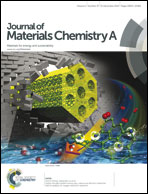Cross-linked polymers of diethynylbenzene and phenylacetylene as new polymer precursors for high-yield synthesis of high-performance nanoporous activated carbons for supercapacitors, hydrogen storage, and CO2 capture†
Abstract
We demonstrate in this article the first use of a family of cross-linked polymers synthesized from acetylenic monomers (diethynylbenzene and phenylacetylene) as new polymer precursors for high-yield synthesis of nanoporous activated carbons of tuneable textural properties. A range of cross-linked polymers of varying cross-linking densities has been tailor synthesized via catalytic polymerization of the monomers. Their carbonization in the presence of KOH as the activation agent renders effectively high-surface-area, predominantly microporous activated carbons of unique textural properties (surface area up to 1418 m2 g−1; pore volume up to 0.78 cm3 g−1) at high yields (ca. 70 wt%). It is discovered that the textural properties of the resulting carbon materials (including surface area, pore volume, pore size and pore size distribution) depend sensitively on the cross-linking density of the polymer precursors and are thus tuneable through polymer design. With their unique textural properties, the high-surface-area activated carbons exhibit superior performance in applications both as electrode materials in supercapacitors and as sorbents for H2 storage and CO2 capture. High specific capacitance (up to 446 F g−1 at 0.5 A g−1 in 3-electrode cell; 334 F g−1 at 0.1 A g−1 and 287 F g−1 at 0.5 A g−1 in 2-electrode cell) has been obtained for the electrodes fabricated with these carbons. Gas sorption study confirms that these carbons show remarkably high capacities for the adsorption of both H2 and CO2 (up to 2.66 wt% for H2 adsorption at 77 K and 1 bar; up to 6.95 mmol g−1 along with a high CO2/N2 selectivity of 11 for CO2 adsorption at 0 °C and 1 bar). These performance properties in all three applications are well comparable to or even better than the best results obtained with various activated carbons to date. The nanoporous activated carbons obtained from this new family of polymer precursors are thus the rare carbon materials that show combined superior performance in all three important applications.


 Please wait while we load your content...
Please wait while we load your content...